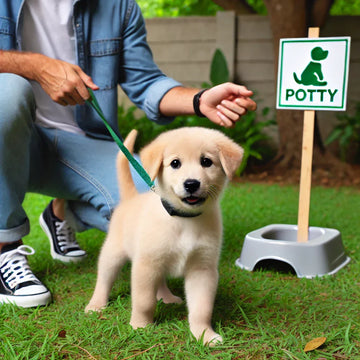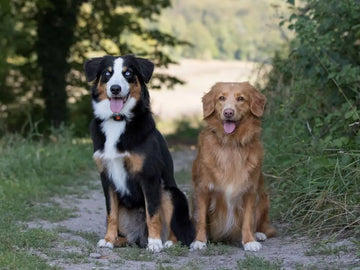Potty training your dog is one of the most important aspects of dog ownership. The process, however, isn’t always as simple as just teaching a dog to go outside; it requires time, patience, and understanding. From the early stages of a puppy’s life to the challenges faced with senior dogs, each stage brings different considerations when it comes to potty habits. In this article, we’ll take a look at how age affects your dog’s potty training and offer tips on how to manage the changes that come with each stage. Additionally, we’ll discuss how to deal with accidents, when to seek professional help, and what supplies can make the potty training process easier.
Puppy Stage: The First Steps in Potty Training
The journey of potty training begins as soon as you bring your puppy home. At this stage, puppies have not yet developed full control over their bladder, and you will need to establish a routine that allows them to relieve themselves frequently. This is a time of discovery for both you and your puppy, as you begin to form habits that will last a lifetime.
1. Early Potty Habits
A puppy’s bladder is small and their ability to hold it is limited. It is normal for puppies to need frequent potty breaks throughout the day, especially after eating, drinking, or waking up from a nap. This is a phase where you need to be patient, understanding that accidents will happen. Puppies are still learning how to hold their bladder and control their urges, so it's important not to punish them when they make mistakes.
2. Establishing a Potty Schedule
Creating a schedule for your puppy is essential for success. At this stage, puppies need to go outside every few hours. Typically, a good rule of thumb is to take your puppy outside first thing in the morning, after meals, before bedtime, and after naps. As you establish a consistent routine, your puppy will begin to understand the connection between going outside and relieving themselves.
3. Positive Reinforcement and Dog Supplies
When your puppy successfully goes outside, be sure to reward them with praise or treats. Positive reinforcement helps them learn that going outside is the right behavior. A simple “good boy” or “good girl” followed by a treat goes a long way in reinforcing these actions.
At this stage, you might need some dog supplies to help manage the training process. Items such as crates, potty pads, and leashes will come in handy during your puppy’s potty training. For example, crates provide your puppy with a safe, controlled space where they’re less likely to have accidents. Potty pads can also be useful for times when you cannot take your puppy outside immediately.
4. Setting Up a Designated Potty Area
You’ll also want to designate a specific spot outside where your puppy will go potty. This creates a consistent routine and helps your dog understand where they are supposed to go. Over time, they will associate that spot with potty time, making it easier for them to learn.
5. The Importance of Cleaning Up After Accidents
Despite your best efforts, accidents will happen. It’s important to stay calm and not punish your puppy. If an accident occurs indoors, use appropriate cleaning methods to remove any traces of scent, which could encourage your puppy to go in the same spot again. Dog cleaning supplies, such as enzymatic cleaners, are specifically designed to break down odors and ensure your home stays fresh.
Adolescent Dogs: Refining and Reinforcing Potty Habits
As your dog grows older and transitions from a puppy to an adolescent, their potty training will need to evolve. During the adolescent stage, dogs have better control over their bladder and can hold it for longer periods. However, this is also a time when they may start testing boundaries. Your dog might begin to act out, ignore commands, or show signs of stubbornness, which can make potty training more challenging.
1. The Transition to Longer Potty Breaks
As your dog matures, their potty breaks will become less frequent. While they may have been going outside every couple of hours as a puppy, by the time they reach adolescence, they can likely hold their bladder for several hours. However, it’s still essential to maintain a routine and ensure they have access to a designated potty area during the day.
2. Challenges of Adolescent Dogs
This stage can be particularly frustrating for dog owners, as adolescent dogs may have moments of regression in their potty training. This could be due to distractions, excitement, or even a lack of supervision. It’s important to remain patient and consistent with your approach, even if setbacks occur.
3. Reinforcing Training with Consistency
You may need to reinforce your dog’s training by going back to the basics. If your dog has begun to have accidents in the house, it’s time to reassess their schedule and provide additional potty breaks. Some dogs may need more frequent reminders, especially if they are left alone for extended periods.
Adult Dogs: Maintaining Good Potty Habits
By the time your dog reaches adulthood, they should have fully established potty habits. At this point, they should be able to hold their bladder for longer periods and will typically go potty during their designated breaks. However, while accidents should be rare in adult dogs, it’s still important to maintain a structured schedule and watch for signs of any changes in behavior that could indicate a problem.
1. Monitoring Your Adult Dog’s Potty Habits
Even adult dogs, who are generally well potty trained, can experience accidents. Sometimes, these accidents may occur due to changes in routine, anxiety, or environmental factors. It’s important to monitor your dog’s behavior and try to identify the triggers for any potty issues.
2. Keeping a Consistent Routine
Maintaining a consistent routine is crucial for adult dogs, especially if they are left alone during the day. Ensure that your dog has a designated potty time, and take them out regularly, even if you are busy. The goal is to avoid situations where your dog feels the need to go inside because they have waited too long.
Senior Dogs: Potty Challenges and Special Considerations
As dogs age, they may experience various health changes that impact their ability to control their bladder. Senior dogs may face issues such as incontinence, arthritis, or cognitive decline, which can make potty training more challenging.
1. Age-Related Changes in Potty Habits
Senior dogs may not be able to hold their bladder as long as they did in their younger years. Incontinence can become an issue, where your dog may have accidents inside the house even though they were once perfectly potty trained. Additionally, conditions such as arthritis can make it harder for your dog to get outside in time.
2. Providing Additional Assistance for Senior Dogs
For senior dogs, you may need to provide more frequent potty breaks. If your dog has difficulty walking or getting outside, consider providing indoor potty options, such as pee pads or a dog litter box. In some cases, using ramps to help your dog get outside can also make the process easier and more comfortable for them.
3. Health Considerations for Senior Dogs
If you notice any sudden changes in your dog’s potty habits, it’s important to consult with your veterinarian. Changes in frequency or accidents may be a sign of a medical condition, such as urinary tract infections, kidney disease, or cognitive dysfunction. Regular checkups are essential to ensure your senior dog is healthy and comfortable.
Conclusion: Ensuring Success Across All Life Stages
Potty training is an ongoing process that evolves with your dog’s age. From the early days of puppy training to managing the needs of a senior dog, each phase presents its own set of challenges. The key is to remain patient, consistent, and understanding of the changes that occur as your dog grows. Providing the proper dog supplies and cleaning products will also make the process smoother. Whether you are training a new puppy or caring for a senior dog, understanding their needs and adjusting your approach will help ensure success.
FAQ Section
Q: How long should I wait to take my puppy outside after eating?
A: Typically, you should wait about 15 to 30 minutes after your puppy eats before taking them outside. This is because eating can trigger the need to go potty.
Q: What should I do if my adult dog starts having accidents again?
A: If your adult dog starts having accidents, it's important to reassess their routine and ensure they have access to outdoor potty breaks. Changes in behavior, such as potty accidents, can sometimes be a sign of underlying health issues, so it may also be helpful to consult with a vet.
Q: How can I help my senior dog with potty training issues?
A: For senior dogs, it’s important to provide more frequent bathroom breaks, and you may need to make adjustments such as using ramps or offering indoor potty pads. Regular vet checkups are essential to ensure there are no medical reasons for the accidents.
Q: Do I need to buy special cleaning products for dog accidents?
A: Yes, using specialized dog cleaning supplies, such as enzymatic cleaners, can help remove odors and prevent your dog from being attracted to the same spot again.
Q: When should I start potty training my puppy?
A: You can start potty training your puppy as early as 8 weeks old. The earlier you begin, the easier it will be to establish good habits. However, remember that puppies have limited bladder control, so they may need frequent bathroom breaks.










